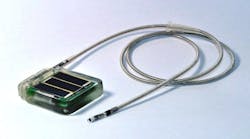Update: Subcutaneous Solar Cells Could Power Pacemakers
Our original January 27 article, “Subcutaneous Solar Cells Could Power Pacemakers,” described a real-life study that looked at the potential of powering medical implants with solar cells. The study discussed the harvesting of data from subcutaneous solar cells, that is, a solar cell implanted in the layer of skin directly below the dermis and epidermis.
To understand this technology, we first have to review the basic concept. A pacemaker is a device implanted in the abdomen or chest area to control abnormal heart rhythms. It utilizes electrical impulses to help the heart muscle maintain a proper rhythm and heart rate. Most pacemakers are powered with a primary battery that requires a replacement when it is depleted.
Implant replacements due to battery depletion can account for about 25% of implantations of cardiac pacemakers. Besides the cost of these replacements, there is always a risk of complications and added stress for the patient. Several approaches have been used to replace the primary battery with one that is rechargeable. Using a solar cell to recharge the battery is one approach.
According to Lukas Bereuter of Bern University Hospital and the University of Bern in Switzerland, the researchers said that their general idea was that the solar cells could directly be integrated into the pacemaker housing. The implant would be located in the neck region (highest light exposure) instead implanted below the collarbone, as conventional pacemakers are.
They developed a first prototype of such an implant (Fig. 1). Their future research aims at developing a similar prototype, but with all flexible components (flexible solar cells, electronics, flexible accumulator) and very thin. Thus, the implant could adapt to the patients anatomy, which may increase patient comfort and decrease implant-related complications.
Bereuter said that this method to power pacemakers using solar cells would avoid the use of primary batteries. Transcutaneous sunlight maybe converted by subcutaneous solar cells into electrical energy to power a pacemaker. This approach would allow batteryless units that would avoid the associated risks of primary battery replacement.


